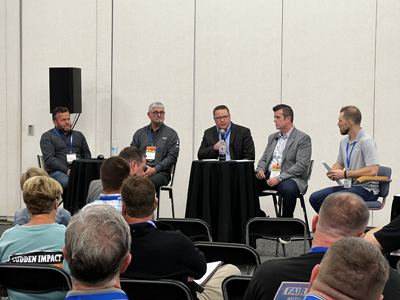“Consistency is the biggest key to success, whether using the BOT or making sure that you consistently write the strongest sheet you can every time,” explained Ayers. “These resources are designed to help you make sure that you are constantly getting the most out of what you are already doing during the repair process in the shop every day.”
In Josh McFarlin’s Collision P.R.E.P. session, the executive VP of operations for AirPro Diagnostics talked about how shops can make more profit and maintain better control of cycle time by keeping ADAS calibrations in-house. From radar recalibrations after a bumper repair to cost-effective static and dynamic calibration solutions, he discussed the pros, cons and cost considerations for multiple approaches.
From an auditors’ perspective, Dennis Smoyer and Rick Miller from Wadsworth International/Subaru and Jaguar Land Rover talked about where repairers are hitting and missing the objectives.
They said it’s not enough to have trained technicians with access to repair procedures and tooling without validation to ensure a consistent quality result. During their presentation, Smoyer and Miller said the Repair Quality Assessment (RQA) process encompasses all aspects from vehicle arrival, administration and discovery through validated in-process quality systems to effectively manage the repair, using tools provided by the vehicle manufacturer.
Mark E. Olson, CEO of VECO Experts, discussed how organization and process can lead to shop profitability.
He encouraged shop owners and managers to get to know their employees and co-workers and learn the specific traits of Baby Boomers (59-76), Generation X (43-58), Millennials/Gen Y (27-42), Generation Z (11-26) and Generation Alpha (under 11).
Olson also talked about the benefits of using a DISC (dominance, influence, steadiness and conscientiousness) assessment with employees. Developed by psychologist William Moulton Marston and taught by Tony Robbins, Olson said DISC details people’s dominant traits in different categories:
1. Analytical---want facts, figures and proof (engineer or architect)
2. Driver---wants it done and done now (highly motivated person, sports, business)
3. Amiable---wants to ensure everyone is getting along (peacemaker)
4. Expressive---wants it to be fun (life of the party)
“Not everyone fits into one category 100%,” explained Olson. “The population is roughly divided equally into all four groups, so it is highly likely that most companies have one of each or more.”

Michael Bradshaw, vice president of K&M Collision and SCRS secretary, shared the step-by-step process of an OEM-compliant repair during his presentation, “Repairer to Repairer: Stop Estimating and Start Repair Planning.”
Bradshaw detailed the processes and documentation used to capture all operations accurately within a repair blueprint. This includes identifying the required repair, documentation best practices and using OEM repair information and industry resources for capturing non-included operations. He also discussed the differences between an estimate and a thorough repair blueprint.
“The blueprinting process is crucial to ensure a proper repair, shop efficiency and overall profitability,” Bradshaw noted.
The educational program also included two panel discussions. One focused on preparing shops for EV repair and management. In addition to Bradshaw and Barry Dorn, of Dorn’s Body & Paint, it included OEM representatives Kelly Logan, senior manager of collision repair program at Rivian; Mark Allen, manager of collision, equipment and EV after sales eervice at Audi; and Jake Rodenroth, North American body repair program operations manager at Lucid Motors.
Bradshaw also moderated a repairer panel that addressed industry issues and opportunities while navigating the future. It included body shop leaders Frank Rinaudo, Frank’s Accurate Auto Body; Dorn; Phil Rice, Huber Collision; and Ron Reichen, Precision Body & Paint.
“Local tradeshows, like the Southeast Collision Conference, allow local vendors to have an impact and to show off their products and services,” said Kent. “They also provide shops education on topics that are relevant today in their shops and see they are not alone.”
“Overall, the CCA and WMABA teams pulled together a great and memorable experience for collision repairers who took the time to come and invest in themselves, their team and the future of their businesses,” said Hendler.










Stacey Phillips Ronak